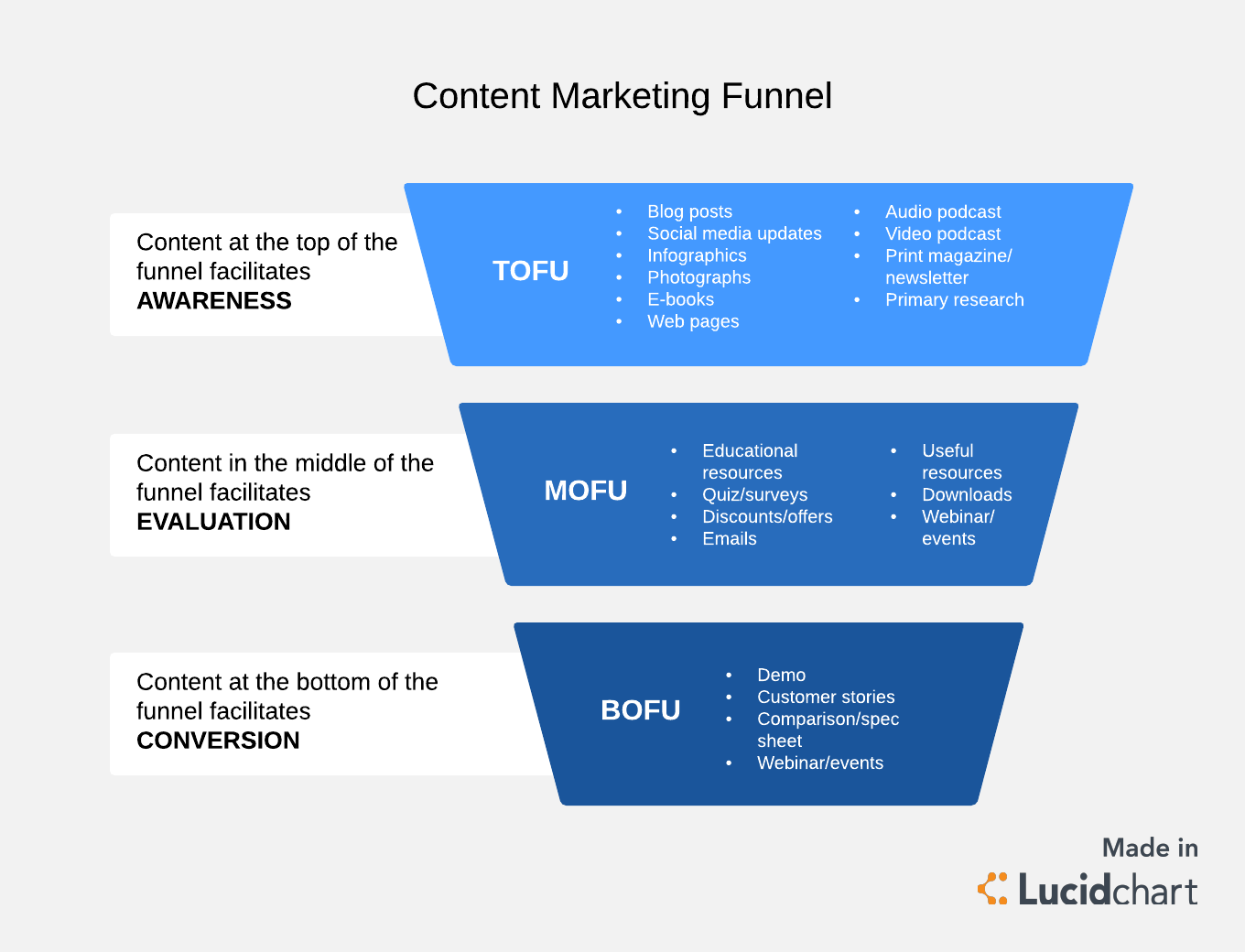Don't Get Stuck in the Void: How a Content Funnel Can Guide Your Audience to Conversion

When I joined as a full-time content manager, I had to do keyword research for new articles. But this wasn’t like I used to do when I was a writer. This time, I had to do it as per the stage of the content funnel.
I had to ensure I was targeting the right audience using the right content. Also, I needed to divide the keywords according to the funnel stage so that we could maintain the right volume of articles for each stage as per our strategy.
So what’s a content funnel?

A content funnel is like a roadmap for your audience's journey from strangers to satisfied customers. It's a series of targeted content pieces designed to attract, educate, and persuade potential customers at every stage of their journey. Think of it as a GPS for your content strategy – helping you guide your audience to their destination: a purchase with your business.
In other words…
A content marketing funnel is like a roadmap that helps a brand use content to get new customers and lead them toward making a purchase. It shows the different steps in the customer's journey, from the first time they learn about the brand to when they become a paying customer.
There are three stages of the content funnel:
ToFu: Top of the Funnel
MoFu: Middle of the Funnel
BoFu: Bottom of the Funnel
ToFu
The top of the funnel is where the buyer journey begins, and it's the stage with the most people. At this stage, people are not yet ready to make a purchase and may not even be familiar with your company.
Their goal: To get information to solve problems, complete tasks, or learn something new.
Your goal: To get people interested in your business and website, help them learn about your brand, show them that you're an expert in your field, and establish your reputation.
Metrics to measure success:
- Organic traffic, referral traffic, and total traffic
- Social media engagement (shares, comments, likes)
- Mentions by influencers and media
- On-site engagement metrics (bounce rate, time spent on page)
- Newsletter and social media subscriptions
Here are some examples of content types that are commonly used for Tofu:
- Blog posts that answer common questions or provide helpful tips related to your industry or niche.
- How-to videos that demonstrate how to complete a task or solve a problem that your target audience is likely to encounter.
- Infographics that provide easy-to-understand information on a complex or technical topic.
- Social media posts that are informative, entertaining, or inspirational, and that encourage engagement with your brand.
- Whitepapers or e-books that provide in-depth analysis or research on a particular topic, and that can be downloaded in exchange for contact information.
- Webinars or live events that provide educational content and allow for interaction and engagement with your target audience.
These types of content are designed to attract potential customers to your brand and begin building a relationship with them, by providing valuable information and establishing your brand as a trusted authority in your industry.
MoFu
In this stage, there are fewer people engaging with your content, but they are more interested and willing to interact with it if you give them a little push.
Their goal: To gain a deeper understanding of the solution that you offer, including both its general aspects and the specific one that your business provides.
Your goal: To educate your audience about your offering and differentiate your business from competitors not only by highlighting features and benefits but also by showcasing your expertise and knowledge.
Metrics:
- Conversion rate
- Number of leads
- Number of visitors
- Time on page
- ROI
- Social shares
- Bounce rate
- Backlinks
There are several types of content that are commonly used for MOFU, including:
- Whitepapers: In-depth reports that provide valuable information to leads in exchange for their contact information.
- Case studies: Real-world examples of how your product or service has helped other companies, which can demonstrate your expertise and build trust with leads.
- Webinars: Interactive online events that allow leads to learn more about your product or service, ask questions, and engage with your brand.
- Ebooks: In-depth resources that educate leads on a particular topic related to your product or service.
- Product demos: Demonstrations of how your product or service works and how it can benefit leads, which can help move them closer to a purchase decision.
- Interactive content: Quizzes, assessments, and other interactive content that engages leads and helps them learn more about their pain points and potential solutions.
BoFu
The last stage of the buyer's journey is called the bottom of the funnel. It's where your content can help make your brand look better than competitors, build trust, and speed up the purchase decision. At this stage, the content you make should answer detailed questions about your product or service, like how it works or what skills are needed to use it.
Their goal: To have trust in selecting both your business and the specific product or service they choose.
Your goal: Not only to drive conversions but also to address any objections and hesitations they may have.
Metrics:
- Conversion rate
- Number of customers
- ROI
There are several types of content/lead magnets that are commonly used for BOFU (Bottom of the Funnel), including:
- Free trials: Offer a free trial of your product or service, so leads can try it out before committing to a purchase.
- Product demos: Provide a detailed demo of how your product or service works and how it can benefit leads, which can help move them closer to a purchase decision.
- Consultations: Offer free consultations with your sales team, where leads can get their questions answered and receive personalized recommendations.
- Testimonials: Showcase testimonials from satisfied customers to build trust and demonstrate the value of your product or service.
- Case studies: Provide detailed case studies that highlight how your product or service has helped other businesses achieve their goals.
- Pricing information: Make your pricing information clear and transparent, so leads can understand what they will be paying and make an informed decision.
Example of ToFu, MoFu, and BoFu content for a marketing agency-

ToFu Content:
Blog post: "10 Reasons Why Your Business Needs a Marketing Strategy"
This blog post targets users who are in the early stages of the buyer's journey and are searching for general information about marketing. The post provides valuable insights into the importance of having a marketing strategy and educates the audience about the benefits of working with a marketing agency.
MoFu Content:
Case Study: "How Our Marketing Agency Helped Boost One Client's ROI by 200%"
This case study targets users who are in the middle of the buyer's journey and are interested in learning more about the results that a marketing agency can deliver. The case study provides real-life examples of how the agency helped a specific client improve their ROI and demonstrates the agency's expertise in delivering measurable results.
BoFu Content:
Free Consultation Offer: "Book a Free Consultation with Our Marketing Experts Today"
This BOFU content targets users who are in the final stages of the buyer's journey and are ready to make a purchase decision. The free consultation offer provides a low-risk way for leads to engage with the agency, get their questions answered, and determine whether the agency is the right fit for their needs.